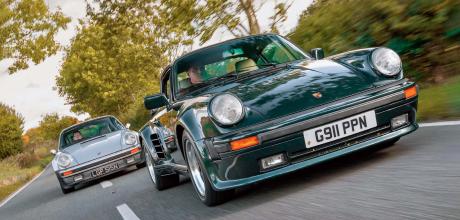First-gen model 1974 Porsche 911 Turbo 3.0 930 test versus rare 1989 3.3 Turbo LE 930
How different are the first 911 Turbo and the last-of-line 930 LE, a UK-only runout model limited to fifty units in 1989? We hit rural Suffolk and sample fantastic examples of both...
Words Steve Bennett
Photography Dan Sherwood
GENERATION GAME 930 TURBO TEST
A TALE OF TWO TURBOS Comparing the first and last 930s
Sometimes, we need to go backwards to work out just how far we’ve come, which is why, sat gently idling on a mellow autumnal morning, we have an original 1975 911 Turbo, reputed to be one of the very first in the country outside of the UK’s press cars. On an N plate, there is really no disputing the fact — whether it’s the second or third 911 Turbo sold in Britain is probably a splitting of hairs.
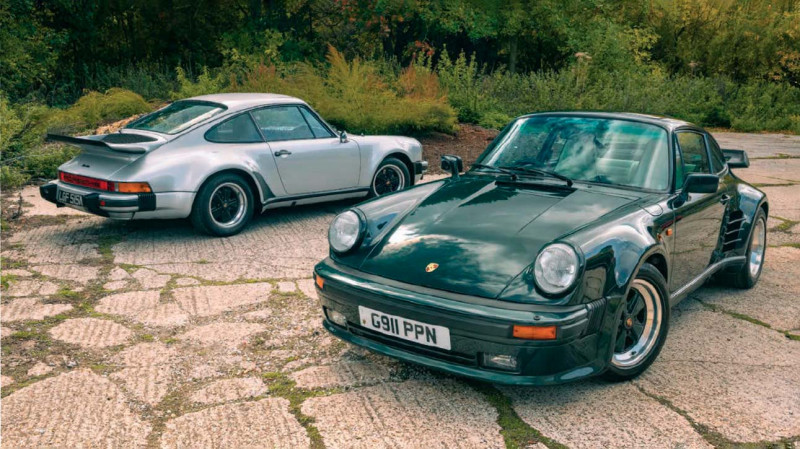
To see how far and fast the first generation of 911 Turbo accelerated from its 1974 launch to its 1989 demise, we also have a last-of-line 911 Turbo LE at our disposal. Both cars come courtesy of the good folk at Suffolk-based independent Porsche servicing, maintenance and sales outfit, PIE Performance, via a customer who collects Stuttgart-crested air-cooled sports cars and other exotica. Bizarrely, he hasn’t driven either of these Porches yet, so we can only be very thankful he is entrusting this dynamic duo to 911 & Porsche World. As days go, this isn’t going to be an onerous one.
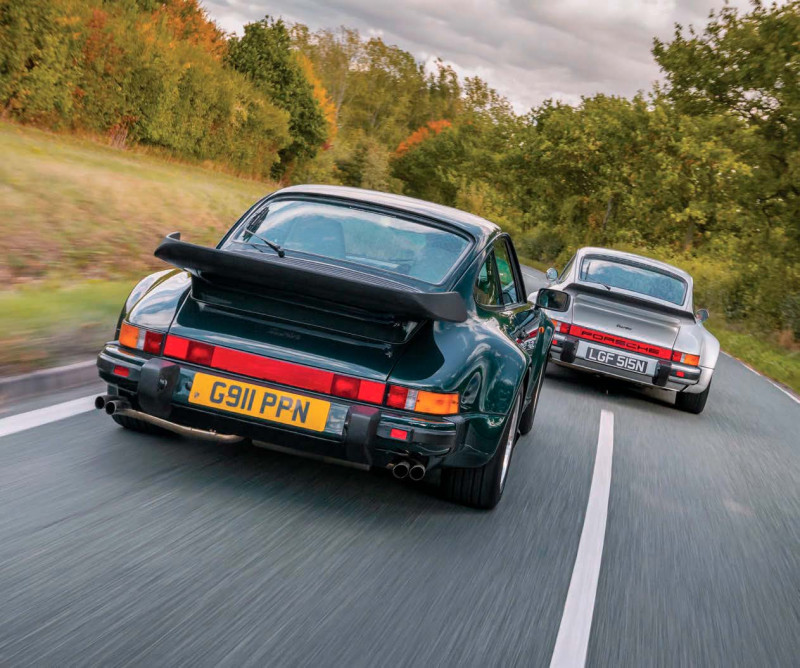
THE MASSIVE SPOILER AND WIDE WHEEL ARCHES WERE THE 911 TURBO’S DEFINING, VISUAL CLUES
PIE Performance head honcho, Chris Lansbury, reckons we’ll soon determine the difference between the two cars is “night and day.” We will find out, but first, a bit of colouring in.
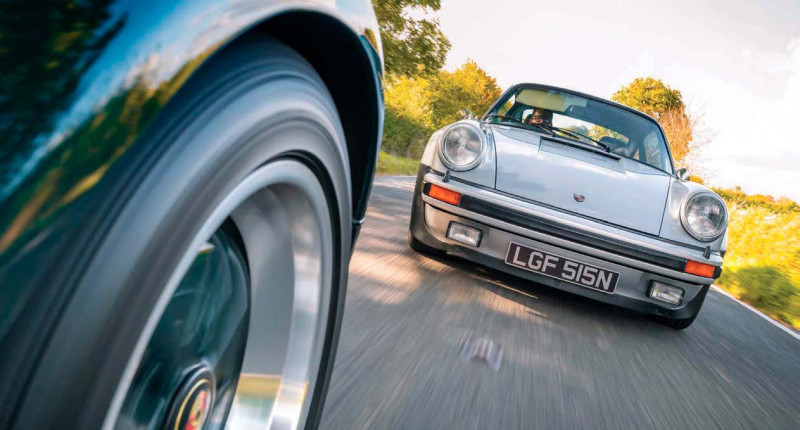
THE LE HAS THAT EXPLOITABLE, TYPICAL 911 CHASSIS WRITHE AND STEERING WRIGGLE
In the here and now world of twenty-four-hour Top Gear, it’s easy to be blasé about supercars. I mean, there’s not exactly a shortage of them. We take them for granted, together with their bloated power figures, top speed and mind-boggling tech. It can be difficult now, however, to appreciate the impact the first 911 Turbo (930, in Porsche speak) had when launched at the Paris Salon in September 1974. Sure, there were supercars back in the black-and-white world of the 1970s, but they were a different breed — fragile, needy, often illconceived and almost always horrible to drive. They possessed dubious dynamics, ridiculous driving positions, equally bizarre ergonomics, gearboxes full of rubble and moody multi-carburetted engines. They were fantasy machines owing nothing to the real world.
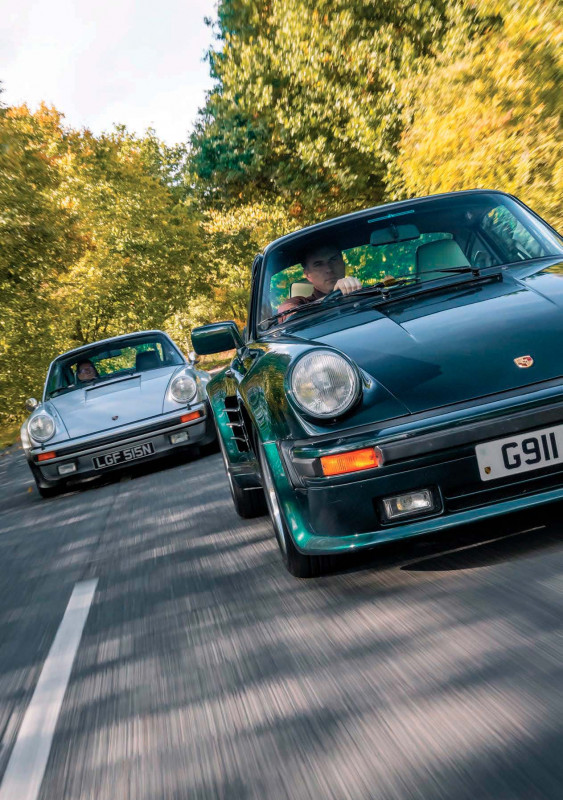
The 911 Turbo changed all this for the better. It threw the supercar rule book in the fire, introducing the unheard concepts of efficiency and drivability. The macho/hirsute (and usually Australian, mate) road testers, weaned on Lambos and Fandangos, were not only awestruck by the Turbo’s sheer pace, but beguiled by the effortless accessibility of what was on offer. Clearly, life didn’t need to be quite so hard. The compromises were gone, the everyday supercar had arrived, and ‘Turbo’ entered the modern lexicon, applied to everything from aftershave to vacuum cleaners. All other top-tier sports cars suddenly seemed obsolete and slightly silly, unless you were Rod Stewart and only a Countach would do.
WHILE THE ORIGINAL TURBO FEELS QUITE LOOSE ON THE ROAD, THE LE IS MUCH STIFFER, MUCH TIGHTER

Within the technological parameters of the day, the 911 Turbo achieved a staggering amount from, well, not a lot. Pragmatic Porsche took what it had and enhanced it. The company’s engineers had already done their homework experimenting with turbocharging in the ‘anything goes’ world of Can-Am, dominated by 917/10s chucking out more than 1,000bhp. Racing improves the breed, as they say. They’d discovered a strong engine will happily cope with a turbocharger. Consequently, it became abundantly clear the racing future of the 911 would be enhanced with a suitable development programme focused on forced induction.
ONE OF JUST FIFTY EXAMPLES BUILT EXCLUSIVELY FOR THE UK MARKET, COMMANDING A PRICE TAG OF £84,000 IN 1989
The 911 Turbo could have been a homologation special built in small numbers, but Porsche’s then top man, Ernst Fuhrmann (designer of the famous Type 547 ‘Fuhrmann’ four-cam), had the imagination to see beyond limited-volume production. Granted, Porsche could have just built the required four hundred cars to make the 911 Turbo race-legit for the period’s Group 4 regulations, but Fuhrmann believed it should be a fully productionised, range-topping machine mixing performance with luxury. Others at Porsche preferred the stripped-out homologation route, but Fuhrmann won the argument and a new supercar world order was born.

The figures are etched in the grey matter hard drives of Porschephiles everywhere. The 260bhp power delivery from the three-litre engine may seem rather tame by today’s standards (it could easily have been 280bhp, but Porsche was worried extra wallop might be a bit tricky for inexperienced drivers), but the real-world, achievable sprint to 60mph from rest in five seconds was a guaranteed Top Trump-winning hand in playgrounds the world over. Also firmly rooted in reality was the 911 Turbo’s 155mph top speed, a figure Italian stallions could eventually beat, but by the time they got there, the 911 Turbo would be long gone, thanks to its strong forcefed mid-range and 253lb-ft torque at just 4,000rpm.

THE ENGINE DOMINATES THE CHASSIS AND GIVES IT A WORKOUT QUITE UNLIKE ANY OTHER 911 UP TO THIS POINT
Of course, this 911 is all about the engine, though Porsche did much more than crudely bolting on what is effectively an air pump. Building a strong flat-six was never a problem. What was crucial to the success of the 911 Turbo — and its drivability — was the installation of the turbocharger. Lag was the enemy, but by combining a Kuhnle Kopp und Kausch (KKK) turbocharger with a Bosch K-Jetronic fuel injection system, plus Bosch’s solid state, breakerless electronic ignition and a clever close-looped control network incorporating a race-derived blow-off valve venting back into the turbo system (rather than noisily back into the atmosphere), Porsche had done everything it could with the technology available. With boost pressure of 0.8bar, the turbocharger started spinning at 1,500rpm, producing a useful kick at 2,500rpm. Peak torque came at 4,000rpm and peak power at a relaxed 5,500rpm.
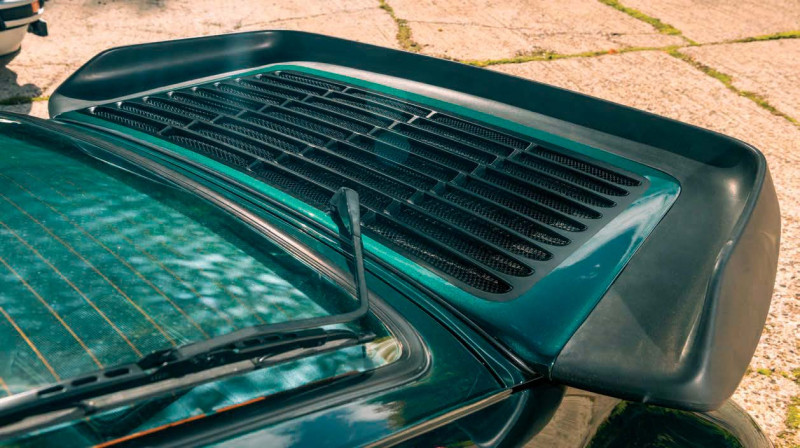
Range-topping machine that it was, the 911 Turbo still had to do its bit to homologate parts for the future racers it would spawn. The massive spoiler and wide wheel arches were the Turbo’s defining, visual clues. Underneath the stretched bodywork, the suspension was modified and beefed-up to endure the rigours or endurance racing, as was the gearbox, which again saw Porsche take the pragmatic approach.
SHAPE SHIFT
While the transmission made much of the 911 Turbo’s need for just four cogs, the reality was more one born more out of necessity than design. The standard Type 915 five-speed couldn’t handle the massive torque, and strengthening it would have meant increasing the size of the transmission housing to accommodate the tougher gears. Better to stick to a four-speed and build a bulletproof gearbox suitable for both road and track aspirations. Trouble is, with just four gears came wide ratios, but we’ll come to this in a moment.
SECOND AND THIRD ARE THE RATIOS OF CHOICE, CERTAINLY IF WE WANT TO KEEP THE TURBOCHARGER SPINNING
Apologies for the history lesson, but the 911 Turbo deserves a certain level of context in order to appreciate its disruptive influence. But now, back in the real world, our early test car is ready and waiting to give us a taste of 1970s supercar action.
And what is it people often say about not meeting your heroes? On this occasion, it doesn’t apply — we’ve driven this particular Porsche before. It was good then and promises the same again.
As intimated, this is one of the earliest 911 Turbos sold into the UK, landing in February 1975 for a heady £14,000. The car is believed to have been used by Porsche for a time. At 71,000 miles it’s largely original, having never been restored or repainted, save for the odd repair to the Zermatt Silver. Defining early car traits are the staggered fifteen-inch wheels and the flatter, less sculpted rear wing owing more to the 1974 Carrera RS 3.0 than the later 911 Turbo ‘tea tray’ rear appendage. The mirrors, too, are pre ‘flag’ — just a simple round chrome job on each side, the passenger mirror almost certainly having been added later.
Climb in. The interior, despite luxurious touches, is still very much basic 911. Well, that’s if you consider four speakers, a cassette head unit, electric windows and sunroof to be the height of sophistication. Needless to say, air-conditioning wasn’t optioned, though it rarely was in the olden days. There’s no complicated throttle pumping start procedure. Flick the key, the briefest of churns and the flat-six catches. Typical of any 915, there’s a slight reluctance to engage first gear, but at least the clutch doesn’t feel like it is set in concrete, even if there is a slight springiness to the cable actuated action. Moving off, there’s no spitty supercar histrionics, just smooth, relatively quiet progress and the muted thump, thump of tyres on tarmac. If you’re new to the classic 911 Turbo, it takes a few miles to work things out, but it’s the gearbox and ratios which dominate almost as much as the engine. First is good for 49mph, second nearly 80mph and third 130mph. Fourth is very much an overdrive, but then again, it will pull happily from 30mph on a whiff of throttle, such is the fuel-injected flexibility.
THE 911 TURBO DESERVES A CERTAIN LEVEL OF CONTEXT IN ORDER TO APPRECIATE ITS DISRUPTIVE INFLUENCE
Effectively, on the rural Suffolk highways and byways of today’s test route, second and third are the ratios of choice, certainly if we want to keep the turbocharger spinning. It’s not so much a problem as a mindset, and makes for a wide and almost relaxed torque-fuelled power band. Hold on a minute! What about the savage power delivery? What about the turbocharger shock and awe? It’s there, it really is, but again, to a degree, those long-range gears disguise the full effect.
As ever, the figures do the talking and they’re all about the torque. As mentioned earlier, peak power is at 5,500rpm, with 253lb-ft of torque from 4,000rpm to 5,000rpm, also known as ‘flat’ in the torque curve world, which is what you feel on the road. Of course, modern turbocharged sports cars will eclipse this no bother, but in 1975, those figures were significant. In comparative terms, a 911 Carrera RS 2.7 produces its 210bhp at 6,300rpm and peak 188lb-ft torque at 5,100rpm.
The contrast between normally aspirated and turbocharging, plus the two very different power curves they produce, is clear to see. The result is that the Turbo is not a point and squirt sort of 911, but get the torque/turbo/ gearing stars aligned and the result is an intoxicating, full fat power surge refusing to tail off until 6,000rpm has been breached. How and when you deploy is the skill in driving this Porsche. And there’s no doubting this early example has lost none of its 260bhp, which is equally aided and abetted by kerb weight of just 1,140kg.
The engine dominates the chassis and gives it a workout quite unlike any other 911 up to this point. In typical 911 fashion, you’ll want to get all the braking and down shifting done before any given corner, and then start to build the boost, so that by the time the steering is unloading and the apex is approaching, the back is starting to push out under power. Then, as the road starts to straighten and it is safe to fully plant the throttle, the rear squats, the engine takes on a more guttural note and — in 1975 terms, at least — something akin to time travel occurs as the distant horizon arrives. This is handy because it’s time to shift to 1989 and the last of the classic 911 Turbos. A quick catch up, though, on the Turbo timeline and development path between the first and the last of these cars.
The original three-litre Turbo was superseded in 1978. The significant change was a capacity and power boost to 3.3-litres and 300bhp, with the addition of an intercooler sitting horizontally directly below the rear wing. Bigger sixteen-inch Fuchs partially obscured new four-pot alloy brake calipers front and rear. The latter was most welcome — the three-litre machine’s braking was the model’s only real weakness. Power and engine specification remained largely the same until end of production in 1989. The four-speed 915 gearbox remained right up until 1988, when the five-speed Getrag G50 (already a feature of the Carrera 3.2) arrived, complete with hydraulic clutch. Typical of Porsche, however, there was an evolutionary development path, mainly in terms of electronics, as new computerised ignition and injection systems were developed.
Incremental improvements to the interior were largely in line with other G-series 911 models, but the Turbo certainly benefited from rather more luxurious carpet and standard air-conditioning, as well as electrically operated seats — even heated — should the relevant options box be ticked. Weight increased by 195kg over the Turbo’s fourteen-year duration, a sure sign of a more comfortable car. Sitting as the cherry on top of the Turbo cake is the LE (Limited Edition), which, of course, is what we have here, one of just fifty examples built exclusively for the UK market, commanding a price tag of £84,000 in 1989. Distinguishing features are the 934-inspired deep front spoiler and side intake strakes cut into the rear arches. Inside, it’s very much ‘world of leather’, complete with a plaque in the centre console acknowledging the Turbo’s fourteen-year production run. Each LE was plucked from the Turbo assembly line and hand-finished by bods in the Exclusive Manufaktur department at Zuffenhausen.
TRICK BIT OF KIT
There’s much more to the LE than just styling tweaks. While 300bhp from 3.3 litres was the default for the vast majority of the Turbo’s time in production, the ‘Performance Kit’ option guaranteed 330bhp, which is exactly what is installed in the rear of the LE and comes courtesy of a larger KKK turbocharger with increased boost pressure, plus high-lift camshafts and a bigger intercooler. The LE also makes use of an exclusive exhaust, with twin pipes at each corner.
And, of course, being a 1989 machine, there’s the five-speed G50 gearbox, too. Quite a machine and, it has to be said, quite the looker in dark metallic Forest Green.
Is Chris right? Is this a “night and day” drive over the 1975 car? Kind of. Perched in the deep bolstered Sports seats, you immediately sit slightly higher. The controls correspond exactly with the earlier car, but the hydraulic clutch is near linear, while first gear slices into position with precision lacking in the more obstructive 915. Steering, though, is heavier with the wider sixteen-inch wheels, but not so much the drive becomes a low-speed workout.

Up and rolling. What becomes immediately obvious is the LE’s get and go. Closer ratios and the computer wizardry of modern engine management hasn’t banished turbo lag, but has largely eliminated it. The LE is much quicker to spool up and so can be driven in a much more conventional style. And with seventy horses over the three-litre Turbo, the LE feels mighty fast, too. It’s worth looking at the numbers, with 330bhp arriving at a still quite restrained 5,750rpm and 318lb-ft of torque at 4,000rpm. This green machine feels as if it is rocking both those performance stats. And while we weren’t about to try, the dash to 60mph from a standing start can be despatched in 4.3 seconds. 173mph was also close to peak performance in 1989.
It’s pretty good in 2022, for that matter. Other compare and contrast observations? While the original Turbo feels quite loose on the road, the LE is much stiffer, much tighter. Clearly, Porsche continued to build strength into the G-Series bodyshell over the years. Damping is tighter on the later car, too. Also, there is more mass in the rear, which you can really feel. Inevitable, given the G50 transaxle is heavier than the 915 and the engine is, of course, heavier with its extra capacity, bigger turbocharger and the addition of an intercooler, plus the air-conditioning pump.
The steering feels slower in the LE, probably in order to contain the rear from any sudden weight transfer. The brakes, though, even by today’s standards are mighty. Oh, and there’s a fantastic noise from the LE’s exhaust. But the 911 traits are all there, if slightly masked by the weight and progress of time. The LE has that exploitable, typical 911 chassis writhe and steering wriggle telling you you’re going to have to show commitment and, perhaps, more than a modicum of skill if you want to go really quickly. Choices, choices. Decisions, decisions. For the very lucky owner of these two cars, there is no decision to be made, but which would we take home? Is it going to be 1975 or 1989? Goodness, this should be a tricky one, not helped by their relative values at between £150,000 and £160,000. Here’s the thing. It’s easy to be last, but to be first is much harder. The 1975 911 Turbo might be something of a preliminary sketch to the 1989 Turbo LE’s, fully finished masterpiece, but it is also the more engaging and challenging to drive. It’s a true time capsule to a pivotal moment, when Porsche joined the supercar wars and showed the rest how to do it in true Teutonic style.
Above Which 911 Turbo would you rather drive home?
Facing page Both 930s offer a thrilling driving experience, though with only fifty examples manufactured, you’re less likely to find yourself behind the wheel of the LE Right The later 911 Turbo features twin tailpipes exiting from each rear corner.
Below It’s hard to follow greatness, but is the pioneering early 930 like a bowl of Kellogg’s corn flakes — original and best?
Facing page 3.3-litre turbocharged flat-six introduced an air-toair intercooler to the Turbo’s engine bay, informing a redesign of the rear end, including the arrival of the ‘tea tray’ spoiler Above Clubsport steering wheel is a Porsche classic.
Above LE’s chunky bumpers and side strakes are typical of the era’s sports cars Below Original 930’s state of dress is altogether more straightforward.
Above Save for the bells and whistles of the LE in 1989, 930 interior didn’t change much from launch to model discontinuation Below All hail the legendary whale tail.
Above The 930 was nothing short of a revelation when it was revealed to an unsuspecting public as a 911 production model line.
Above Two of a kind, separated by near fifteen years of 930 model development Below The Turbo’s original three-litre flatsix, sans intercooler.


